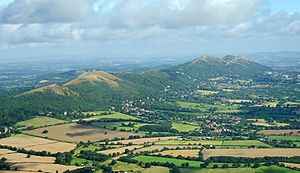Malvern Chase facts for kids
Malvern Chase was a special area of land, like a big hunting ground, that belonged to the kings and queens of England. It was located between the beautiful Malvern Hills and the River Severn in Worcestershire. It also stretched into Herefordshire, from the River Teme to another area called Cors Forest.
Many towns and villages were once part of Malvern Chase. These included Hanley Castle, Upton-upon-Severn, Welland, Longdon, Birtsmorton, Castlemorton, Bromsberrow, Berrow, Malvern, Colwall and Mathon.
A Look Back: Malvern Chase History
The exact start of Malvern Chase as a royal hunting ground isn't fully known, but it became a royal property during the time of King Edward I. He gave it to a powerful nobleman named Gilbert de Clare, who was the Earl of Gloucester. From then on, it was officially called a "Chase."
Over many years, the ownership of Malvern Chase changed hands several times, often through marriages and inheritances. For example, another Gilbert de Clare married a woman named Maude. When he died without children, his lands, including Malvern Chase, went to his sisters. One sister married Hugh le Despencer, and the Chase stayed with their family for a few generations.
Later, the land passed to Richard Beauchamp, Earl of Warwick, a famous general during the reign of King Henry V. His son, Henry Beauchamp, became a Duke but sadly died very young at just 22 years old. Since he had no children, his lands, including Malvern Chase, went to his sister, Ann.
Ann was married to the famous Richard Neville, often called the "King-maker" because he had a big influence on who became king. He had two daughters, and after his death, his lands were divided between them. One daughter, also named Anne, married Edward, the son of King Henry VI. After Edward died, she later married Richard, Duke of Gloucester, who became King Richard III.
The other daughter, Isabella, married George, Duke of Clarence. Their son, Edward, was the last heir in this line. Sadly, he was later executed, and King Henry VII took control of all his lands. This included the Hanley Castle and the surrounding parks and towns like Upton-upon-Severn. These lands then remained under the control of the Crown until around the 1630s.
Changes and Challenges: The Disafforestation of Malvern Chase
In the 1620s and 1630s, King Charles I needed money. To get it without asking Parliament, he decided to sell off parts of the royal forests and chases, including Malvern Chase. In 1630, he granted one-third of the Chase to two men, Sir Robert Heath and Sir Cornelius Vermuyden.
However, many local people had long-standing rights to use the land within the Chase. They used it for grazing animals or collecting wood. When the new owners tried to fence off parts of the Chase, these local people were very upset. This led to many protests and even riots. Similar protests happened in other parts of England at this time.
Despite the protests, a special order was issued in 1632. This order officially changed Malvern Chase from a royal hunting ground. It meant that deer would no longer be kept there, and the old "forest laws" would no longer apply. The order stated that only one-third of the land would be taken by the new owners, and the other two-thirds would remain for the commoners to use, free from the old royal hunting rules.
There were still arguments about which parts of the land would be taken. It was decided that the land taken had to be fair and not just the poorest quality land, so that the commoners still had good areas to use.
The Future of Malvern Chase Lands
After 1660, King Charles II agreed to the new arrangements for Malvern Chase. Over time, the Chase gradually became smaller as more land was developed or used for other purposes.
However, in the 1800s, people became more interested in protecting the beautiful Malvern Hills. This led to the Malvern Hills Act 1884. This important law created the Malvern Hills Conservators, a group whose job is to look after and preserve the Malvern Hills area and manage how its land is used. This helped protect what was left of the historic Malvern Chase.


